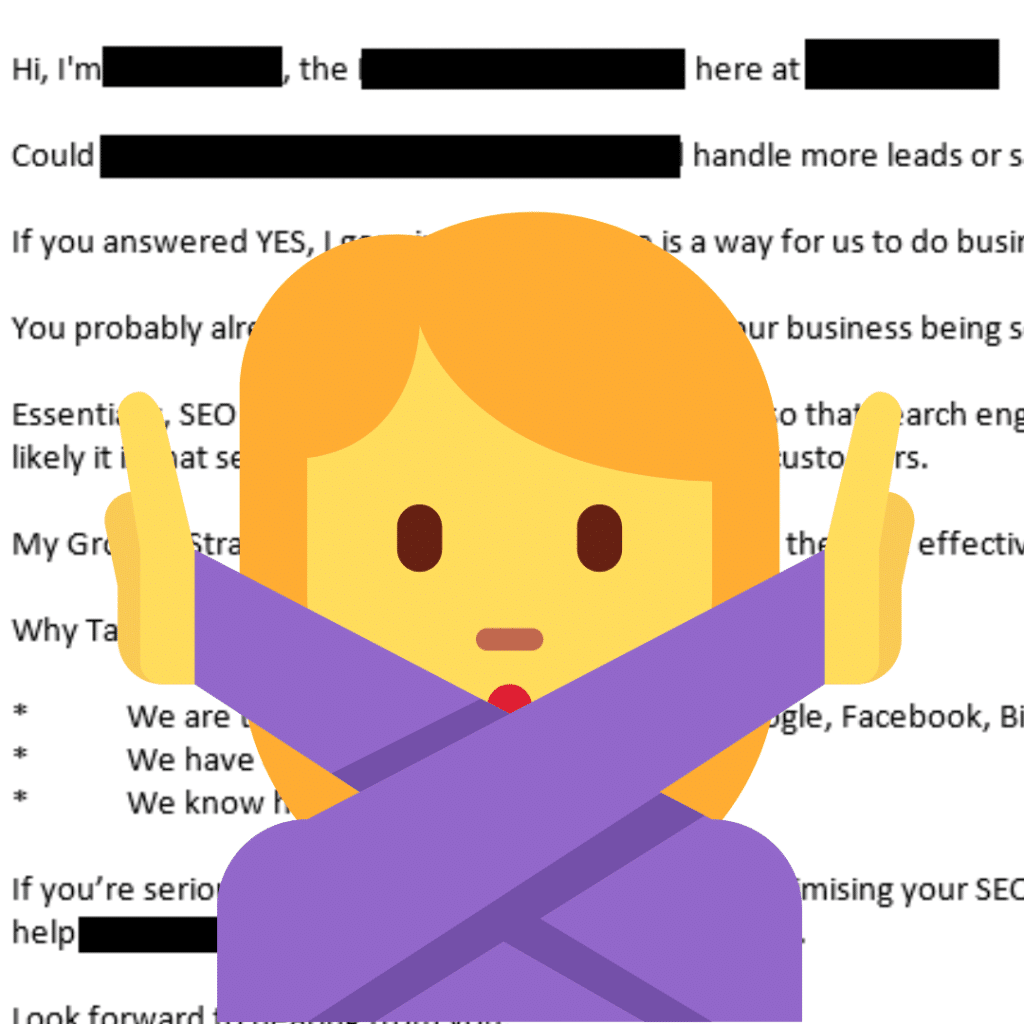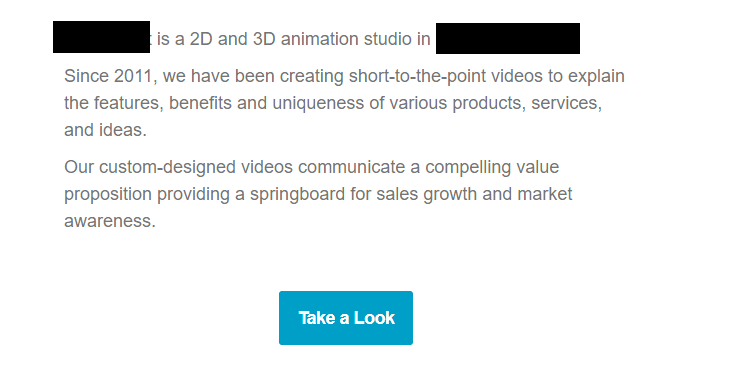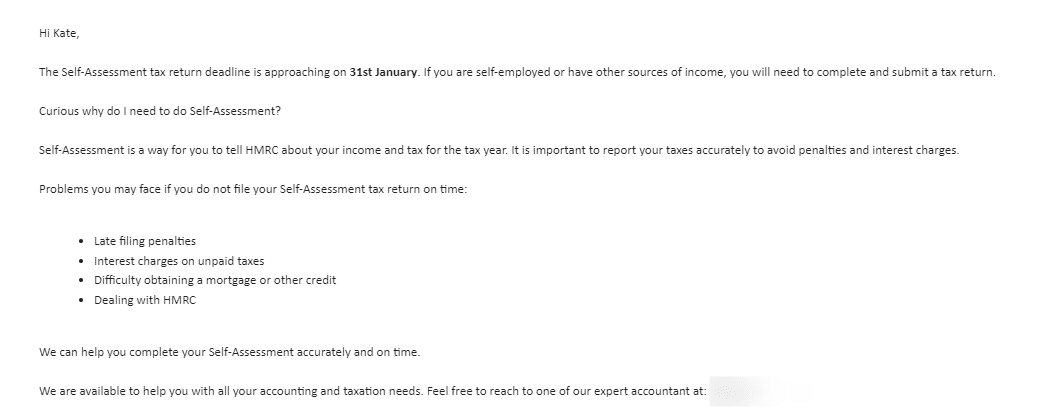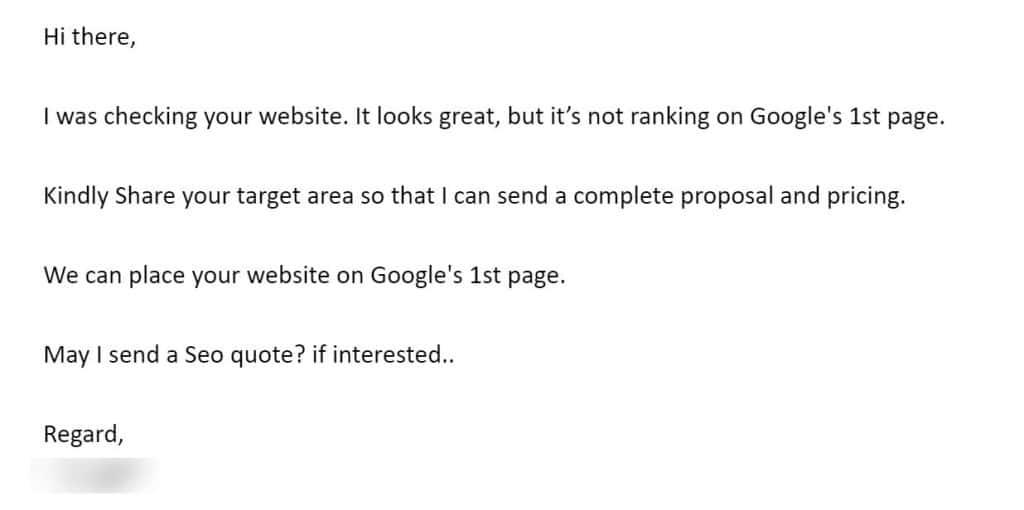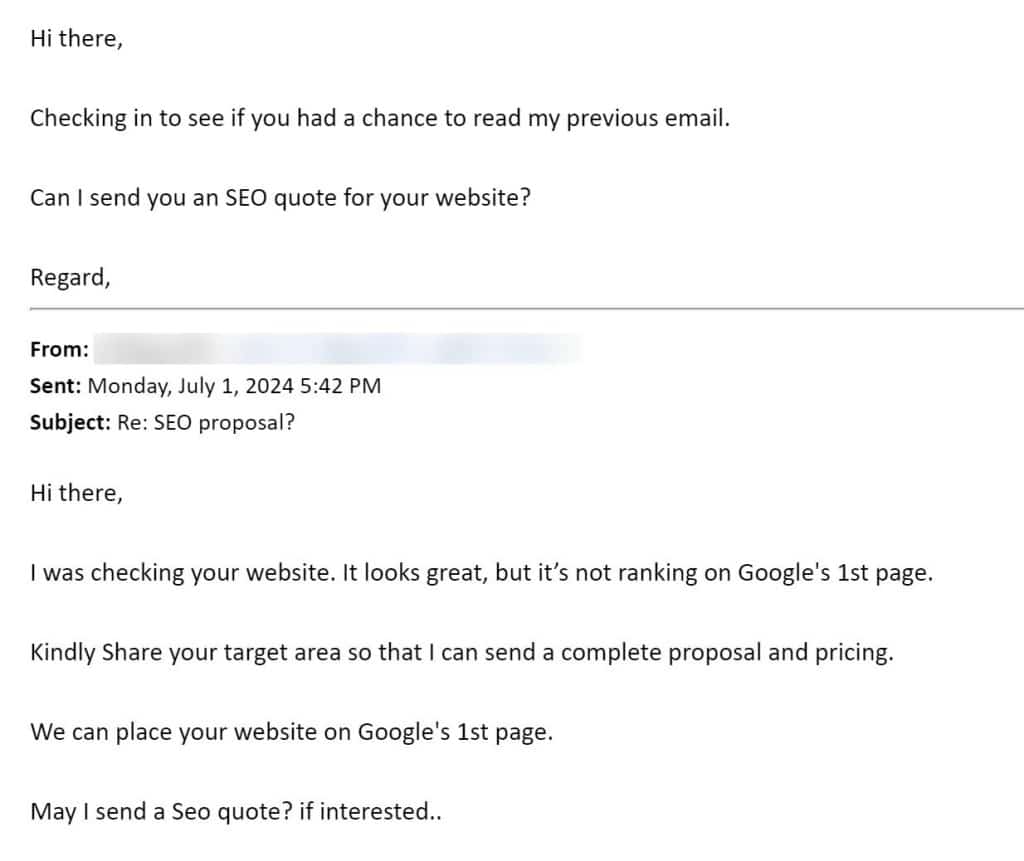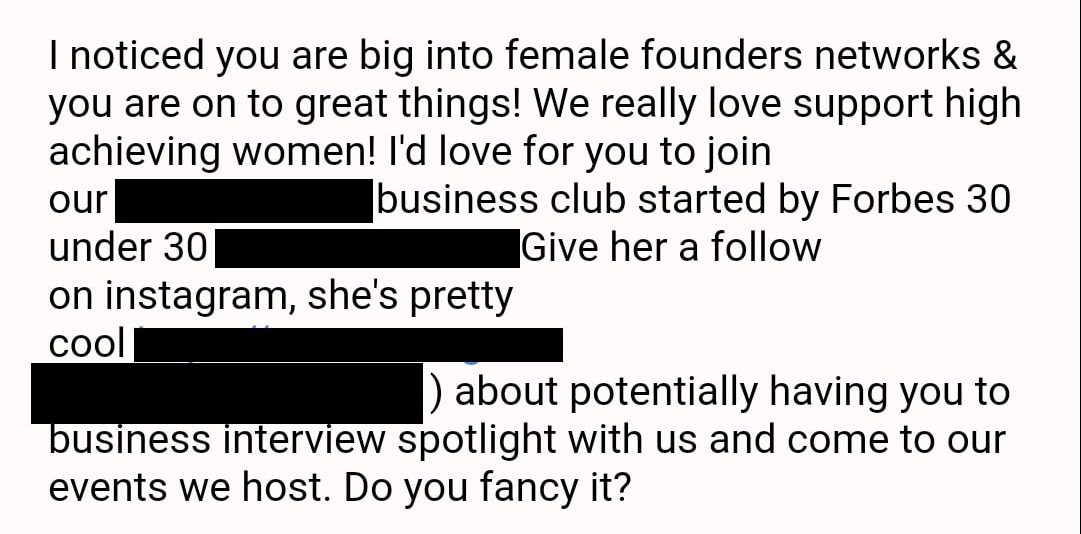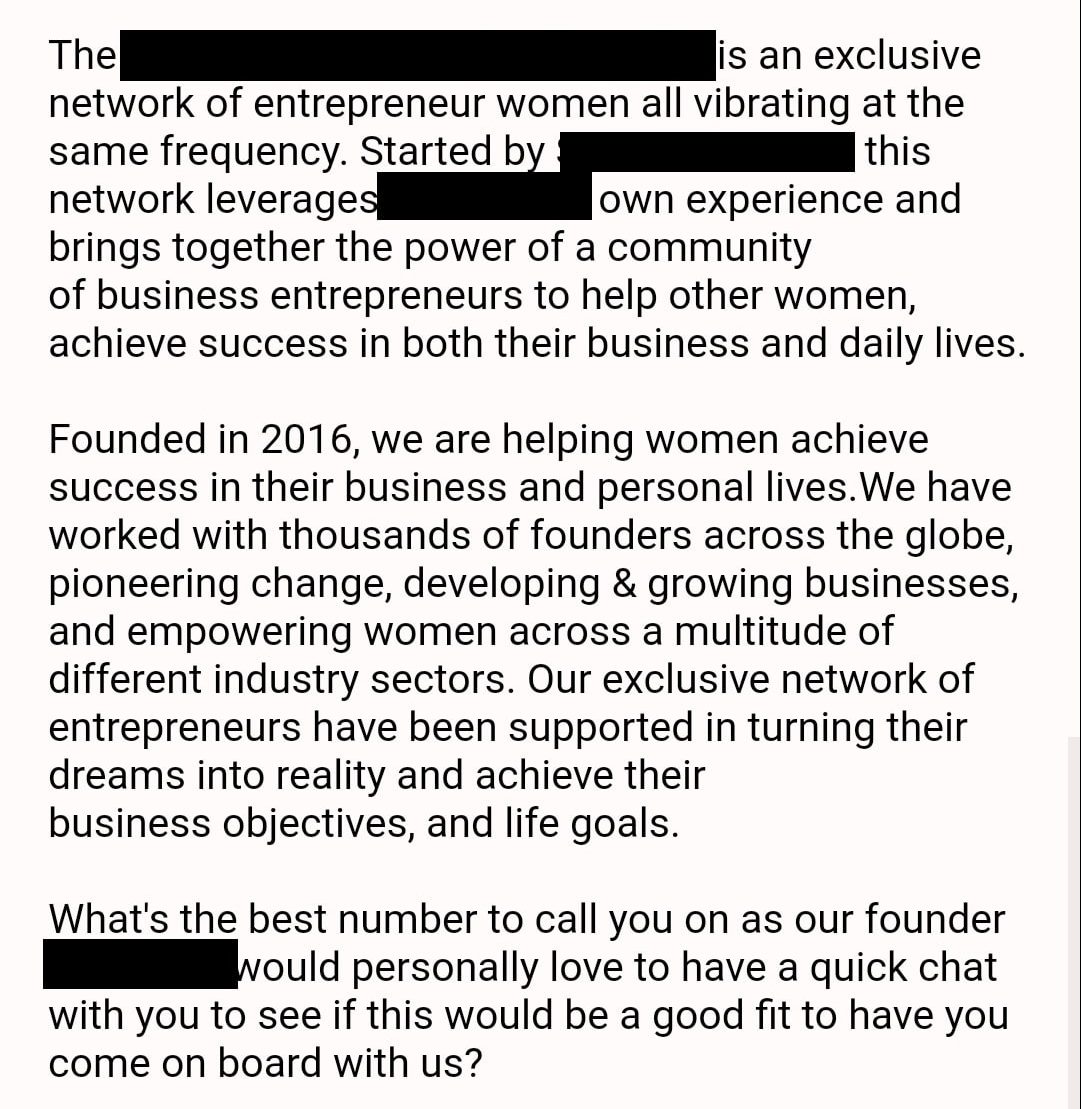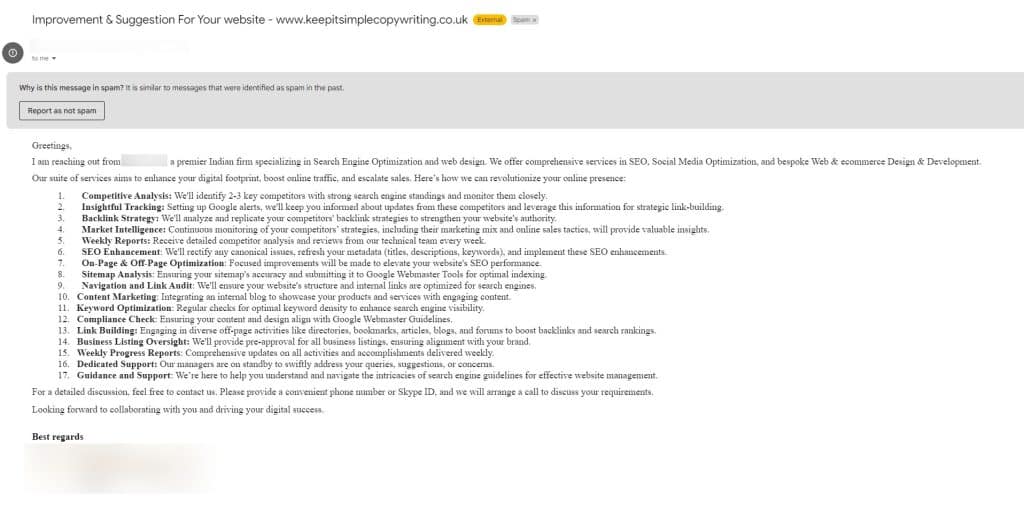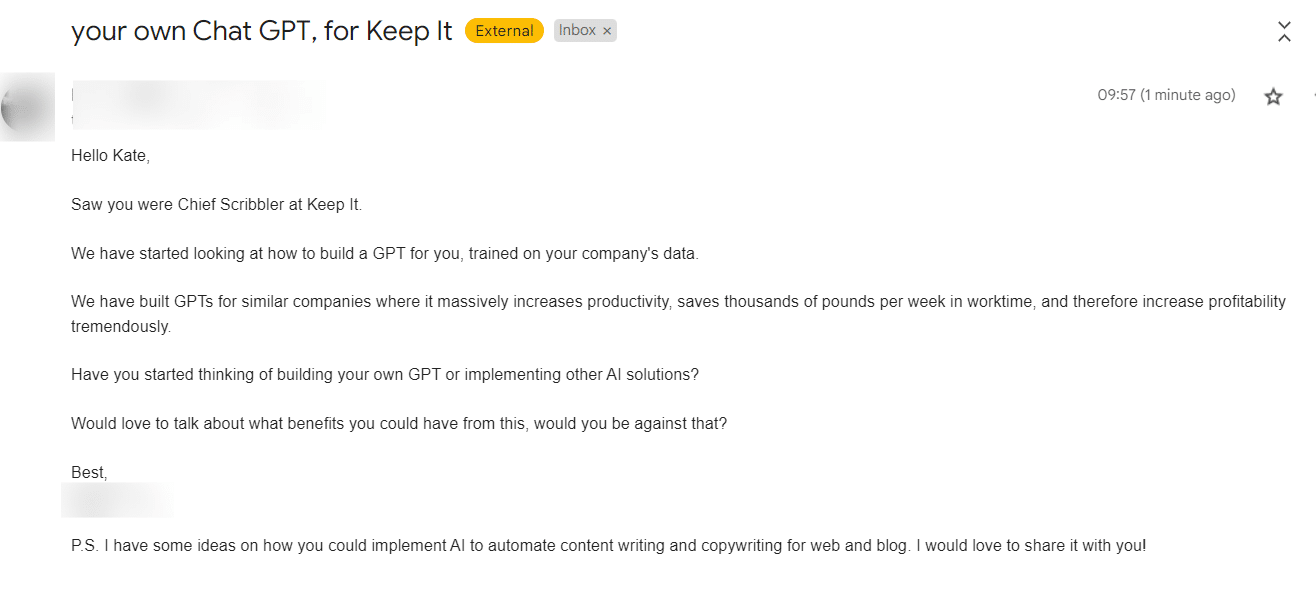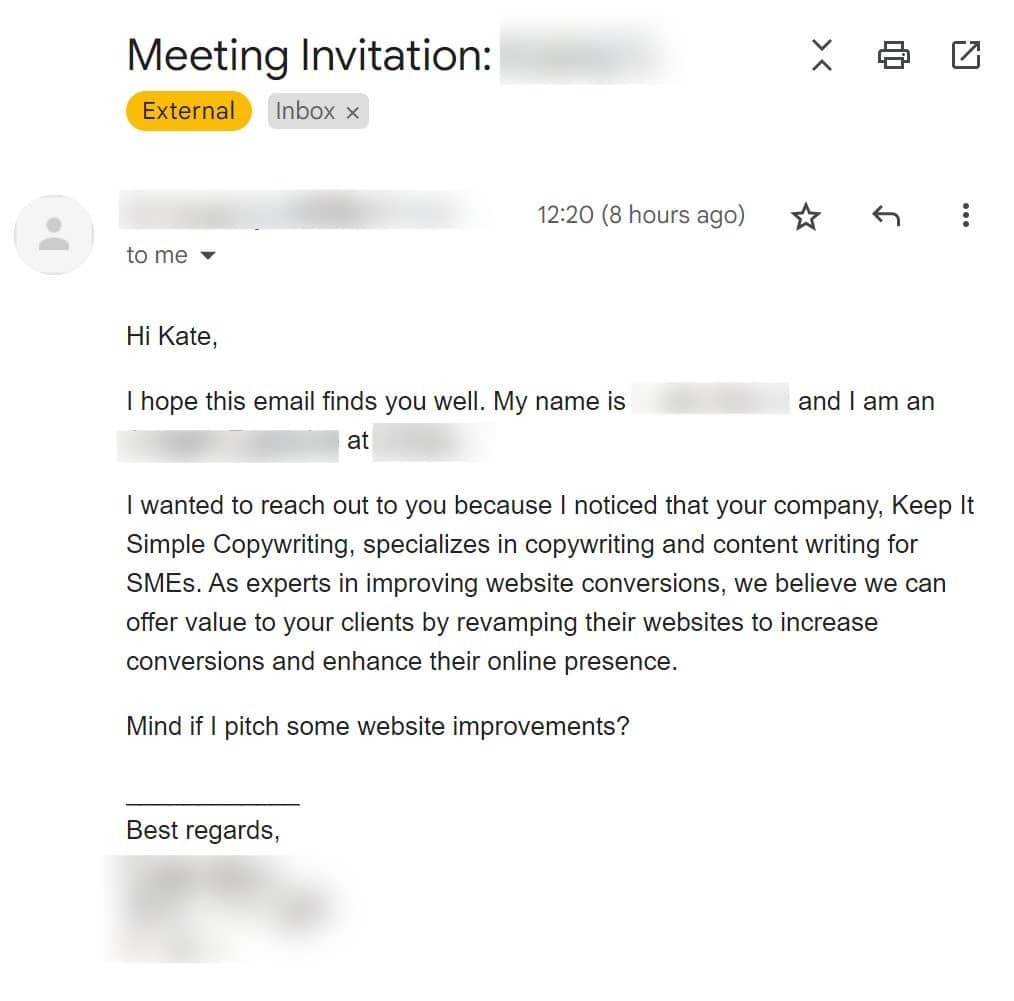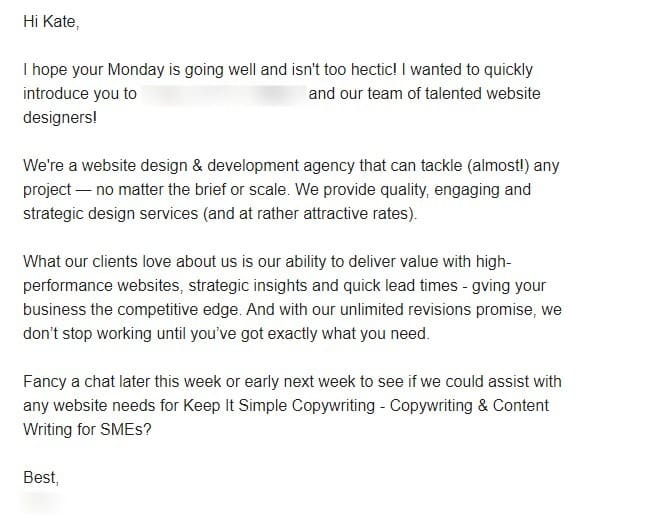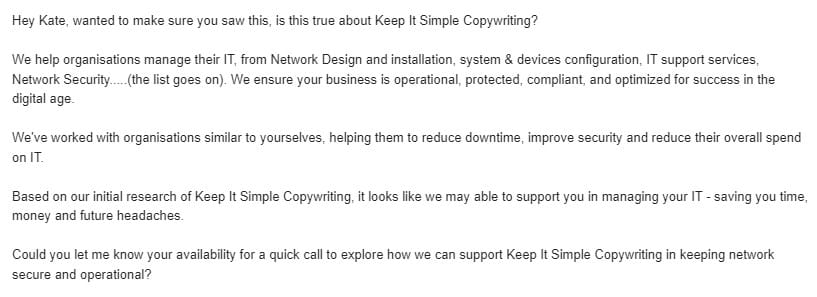Only three things are inevitable in life. Death. Taxes. And getting rubbish cold emails for products and services you don’t want.
I don’t know about you, but I get a heck of a lot of emails from companies trying to sell me things.
A small minority of them are highly targeted and well-written.
However, most of them are terrible. They sound like they’ve been churned out so a sales development representative can meet quota that month.
Rather than sending these emails straight to the recycle bin, I’ve decided to make them a bit of a learning experience.
I’ll show you what these cold emailers have done wrong, and how you can avoid making the same mistakes as them in your email marketing campaigns.
I’ll add emails to this article as and when they land in my inbox, so keep checking back regularly for new content.
And if you send me spammy emails, bear in mind I might unpick them on this page – don’t say I didn’t warn you.
(If any of the emails are a little small, just click to embiggen.)
You make it all about you
When writing web copy, whether for a landing page or blog post, it’s vital that you focus on the needs of the customer.
You need to identify your customer’s pain points and show them how your products or service can benefit them
The same logic applies to cold emails. If you harp on about how great you are, you’re not going to get anywhere at all.
Example 1: Check your we’s
Copywriter Steve Harrison famously said that you need to count the number of times you say we in your content, versus the number of times you say you.
If you’re saying the former more than the latter, it’s probably time for a rewrite.
In this email, number of we’s and ours: two. Number of you’s: none. Back to the drawing board.
In situations like this, you can usually flip things around to the customer’s point of view fairly easily.
For example, the email talks about sales growth and market awareness. So you could write something like:
Looking for an innovative way to show off the unique selling points of your products and services?
We create short, snackable 2D and 3D videos that tell your customers who you are and what you do.
With our expert team, you’re one step closer to boosting your sales and raising your brand awareness.
Number of we’s and ours: two. Number of you’s: seven.
Boom. Mic drop.
You write too much
Cold emails need to be short.
You want to introduce your brand, tell potential customers what you do, and explain the next steps you want them to take.
Save the longer, more descriptive emails for customers who are in the middle and at the end of the sales funnel.
Ideally, a cold sales email should be 120 words or less. If you have a lot to say, you can get away with 150 words at a push.
But any more, and a prospective customer is going to roll their eyes and send your email to the recycling bin.
Example 1: Nah, I’m not reading that
Here’s an example of a cold email that is way too long. This bad boy comes in at a staggering 325 words. Yes, I was sad and counted.
People are busy, and their attention spans are short. The average person gets about 120 emails in their inbox a day.
(I get significantly more than that when I’m asking for email pitches.)
So, how could you reduce the length of this email? Here are my thoughts:
- Ditch the ‘hope you are well‘. The first line of an an email is the most important as you need to grab the reader’s attention. Scrap the wishy-washy pleasantries, they don’t work
- The word choice is very fluffy. For example, you could condense the whole first paragraph to ‘If you’re looking for a lead generation and appointment setting provider to help with your B2B marketing campaigns, we’re here to support you’
- The email goes into extensive detail about how the lead generation process works. You don’t need this information in an introductory cold email. If anything, talking about how long a campaign needs to be is a turn-off. Save the nitty-gritty for a future email
This email does have some good things going for it. For example, it includes a tangible stat about the return on investment the company offers, which is great.
It’s just way too wordy.
Example 2: Don’t send an email if you don’t understand your audience
Here’s another email that doesn’t work.
While it’s considerably shorter than the previous example, it could still be a lot more precise.
The issue I have with this email as the target customer is that I’ve been self-employed for many years.
I know all about self-assessments, tax returns, and that if you don’t fill in the right forms, they send Jeremy Hunt around your house with thumb screws.
(Hey, don’t threaten me with a good time.)
Given the target audience, this email is way off the mark.
It talks at length about what a tax assessment is and why they’re important. Pretty much everyone who needs to do a tax assessment knows why they need to do one.
Here’s my attempt at cutting the fluff and making the message more on point:
It’s that time of the year again – the self-assessment tax return deadline is just around the corner.
Fed up of going through your receipts and worrying that you’ve got your numbers wrong? With our accounting and taxation services, we’ll give you peace of mind and ensure you complete your self-assessment on time.
One less thing for you to worry about. Reply to this email to see how we can help.
You get impatient
It’s likely that your cold email may get lost in a prospective customer’s inbox. They might be busy. They might be on holiday. They might have saw your email and just forgot to reply.
In this situation, sending a follow-up can help you make that all-important sale. However, you need to time it carefully. Send it too soon and you risk annoying your prospect. Send it too late and they might forget you exist.
What’s the optimal frequency for sending a follow-up message? I recommend a week, but YMMV. Try different time periods and see which one leads to the best results.
Example 1: Why are you ignoring meeeeee?
Here’s a particularly frustrating chain of emails I got. The first – your typical spam email telling my that my SEO sucks and I need to use their services. Not interested, so I ignore it.
(By the way, if an SEO specialist says they can get you on the first page of Google – MASSIVE red flag.)
This email was sent to me at 5pm on a Monday. The next day at 3pm, not even 24 hours later, I get the following:
There are times where sending a follow up sales email less than a day later is acceptable. For example, if a customer has accepted a quote and you want to remind them to sign the contract before the momentum wears off.
But not when you’re shilling crap SEO services.
Anyways, here’s the next email I got at 6am the next morning – just over 12 hours later.
Needy much? I think I’ll pass.
You go off on a tangent
A cold email should be a simple journey from A to B. You start by introducing yourself and your services and end with a solid call to action.
If your email is a complicated road trip with multiple pit stops and having to pull over every couple of miles to check the map, you’ve got yourself a problem.
Example 1: What was the point of this email again?
I got this email a little while ago – I read it and didn’t understand the point of it. And I’ll be honest, I still don’t.
This one’s a bit wordy, so let’s break it down step by step.
Fairly standard starting paragraph. Not a big fan of the ‘I hope you are well and don’t mind me reaching out to you’.
If you act like you’re being a nuisance, your reader is going to think you’re being one. Be confident in what you’re pitching.
This is where things get weird. Not only is the writing clunky, but there are three different call to actions here.
The first is to join a business club, the second is to follow a woman on Instagram, the third is to arrange some kind of interview.
With a cold email, you need to stick to one main focus. When you deviate and try to get a prospective customer to do many things, you just confuse them. Pick a lane and stick to it.
Although this is a personal preference, I would avoid putting links and attachments in your initial cold email, like they did to the founder’s Instagram account here. This can distract and confuse the reader.
The final part of the email is a bit meh. There seems to be a fixation about how amazing the founder is and how following her will clear your skin and water your crops.
While I’ve redacted her name, let me just say – I’ve never heard of her.
You can easily condense these three paragraphs into one – a quick introduction to the group, who it’s for, and how you can benefit from joining. Done.
Keep it simple and stick to one clear purpose.
You try and be too clever
Did you know the average reading age in the UK is 9 years old?
On top of that, people are only going to scan an email for a few seconds before deciding whether it’s something they want to interact with.
This means it’s important to keep your wording clear and avoid complicated phrases that are going to make your readers need to dig out their dictionary.
Example 1: Well, that backfired
Here’s an example of weird wording that I spotted in a cold email.
‘Time insensitive methods’ is not an easy phrase to understand. I’d have stuck with saying something like ‘hundreds of companies use us to save time.’
More words? Yes. But it’s an easier concept to understand.
Is jargon ever okay to use in a cold email?
It depends on who your target audience is. If you’re selling lab equipment or chemicals to scientists, you’ll need to use specific terminology to get your point across.
If you’re selling it to office managers, you may need to simplify things a little.
You tell people absolutely nothing
We talked about being too clever and complicated, but the needle can swing too far the other way as well.
It’s possible to send an email that tells potential customers sweet FA about you.
Example 1: Blah, blah, bland
Here’s a lovely example of an email that’s as boring as an unseasoned chicken breast.
Short? Tick. Clear(ish) call to action? Tick. But the middle section is terrible.
Let’s start with ‘I’m hoping to discuss how, if at all, you would like to improve your website?’
One of the worst things you can do in a cold email is to give your customers a potential out.
The ‘if at all’ makes customers think that their website is fine, so they don’t need to get in touch.
Well done, you’ve just talked yourself out of a sale.
Next: ‘I’m sure you receive many emails offering something similar, meaning I need to try and stand out’.
Yes, you need to offer a unique selling point to distinguish yourself from your competitors. But the issue is… you haven’t given one.
Finally: ‘I pride myself on the service we provide, I have many testimonials to back this up’.
Let’s ignore the we/I pronoun confusion for a moment.
Where are these testimonials? If you have social proof, put it in your email. Don’t say you have social proof and leave it off the table.
Let’s try and reword this email and make it better:
When you’re looking to redesign your website, you want it done by the best of the best. At Awesome Webdesign Limited, we pride ourselves on high-quality service at affordable prices.
Our expert team of web developers recently implemented a replatforming on behalf of AcmeCo. They saw their web conversions increase by over 150% as a result of our hard work.
We’d love to have a ten-minute chat with you to see how we can transform your website and give you the edge over your competitors. Are you free tomorrow afternoon?
You don’t do your homework
Many people think that cold email is all about grabbing a list of addresses and firing off the same generic email to them all in the hope that someone takes the bait.
Nope. Personalisation and targeting are important no matter what part of the sales funnel you’re focusing on.
You need to do your research and craft your email so it appeals to the reader.
Example 1: Bye-bye existing customer
Here’s a stinker I got when I was working in marketing. It’s from a UK-based mobile phone provider. I won’t name it, but it’s not Vodafone. Or EE. Or O2. Or even Tesco Mobile.
I’m sure you can fill in the gaps yourself.
For a start, the email isn’t personalised, not even with a name.
Next, and this is probably very important, the company I was working for was using this mobile phone provider all along. Yep, if they’d done their research, they’d have seen we were already a customer.
This happens a lot more than you might think in business and it’s not a good look.
Come on, it only takes a couple of minutes to look at a CRM system and pull out a list of existing customers.
Example 2: They had us in the first half…
I usually ignore the Indian SEO spam emails as they’re all terribly written – waaaaaay too much of an easy target for blog posts like this.
But this email was particularly vexing.
The subject line for this email is actually good, random capitalisation aside: ‘Improvement and suggestion for your website’.
If I got an email like this, I’d be tempted to read it, in the hopes I got some personalised feedback that could help me develop my site.
Unfortunately, the email doesn’t offer any specific information about my site, it just produces a generic list of all the services the company offers.
Cheers – I just wasted twenty seconds of my life reading your email, which I’m never going to get back.
I hope you’re proud of yourself.
Example 3: You might want to fire your business development person
When you’re writing sales emails, it’s best to create a handful of highly-targeted emails for a relevant target audience, rather than adopt the old ‘spray and pray’ approach.
This example here was particularly frustrating. Not only was the email bad (remember, sell the benefits to the customer rather than boast about how great you are), but the sales pitch was baffling.
I work in copywriting, not packaging. The only time I get involved in handling cardboard boxes is when I take in an Amazon order for the next door neighbours.
This business development rep has wasted hours whacking together a sales list that will result in no leads at all. The better option? Spend time finding people in industries that are likely to need packaging, for example, those working in logistics or eCommerce.
And by the way, when I replied to say I wasn’t interested, I got a bounceback saying the inbox wasn’t available. So you might want to work on that too.
You don’t give customers a reason to trust you
We’re all tempted to lie on things – CVs, mortgage applications, tender submissions. However just because you can doesn’t mean you should.
Emails are all about building a relationship with a potential customer. You want them to trust you enough to want your product or service.
Break that trust, and it’s all over.
Example 1: Why are you so obsessed with me?
Here’s an email I got from an AI company founder.
I generally cringe a little inside when I get a cold email from a company founder. When an email comes from someone in the sales team, it’s generally (but not always) well written – these folks know the fine art of selling after all.
However, an email from a founder typically follows the thread of ‘I love this product or service, so you should too. Pleeeeeease love my product or service’.
Okay, so where to begin with this one?
Good points – I like the addition of a P.S. at the end and how the question is in the middle of the email rather than the start. This means you’re not automatically turning people off.
The rest though…. pfft.
For a start, never begin an email with ‘I saw you were X at Y’. This is wasted real estate and adds nothing to the conversation – the reader knows where they work and what they do.
It’s like saying ‘Hey, I heard you like food’ or ‘I heard you like to breathe air’.
And if you do go down this route, get the details right. It’s ‘Keep it Simple Copywriting’, not ‘Keep it’. If you’re going to scrape content from LinkedIn, at least check it before you hit send.
The bit that makes this founder a liar-liar-pants-on-fire though, is this line. ‘We have started looking at how to build a GPT for you, trained on your company’s data’.
First, creepy AF. Secondly, have you really? Have you really looked at a teeny weeny freelancer’s website and started to create a highly advanced AI model, just for me?
I don’t think you have.
If you’re using account-based marketing and are trying to court a billion-pound business with their own bespoke GPT, this line would check out. But you wouldn’t do it for a small microbusiness.
(Update: I did ask some sales friends about this, and they said usually what happens is that they start creating the GPT if you express an interest in the product. That makes sense, but it’s still a big old lie.)
And finally, don’t tell a freelance copywriter how they can use AI to automate their work. It’s like going up to a vegan and asking how they like their steak cooked.
Example 2: Sad, sad subject lines
I’ve not touched on subject lines much in this article – there’s a lot to unpack though and it’s probably something for another blog post.
However, your subject line can make the difference between a potential customer reading your email and thinking you’re a bit shifty.
Here’s a classic – adding a ‘re’ or ‘ref’ to your subject line to confuse your email recipient into thinking they’ve already spoken to you.
It’s not big, and it’s not clever.
Will more people open your email? Yes. But will more people get annoyed when they find out you’ve tricked them? Absolutely.
Another disadvantage of doing this is that email servers can easily identify a fake ‘re’ in a subject line.
This increases the odds of your email message being marked as spam.
Example 3: Here’s my advice – write a better sales pitch
Picture the scene. You get a message from someone who’s a massive fan of your work. They’re just getting started and they’d love to get some advice from a expert such as yourself. Flattered, you agree to jump on a Zoom call.
However… they don’t want your valuable insights at all. They want to sell to you. Dun-dun-dun!
The tell-tale sign that gives this email away is that it’s inauthentic and vague – the person probably sent the same email out to 500 other people. If it was genuine, they’d have mentioned something they liked about my work.
When you send emails like this, you’re starting your working relationship on the wrong foot. You’ll trick someone into a call sure, but they’re not going to buy from you.
And after they’ve hung up on you for wasting their time, they’re going to tell their friends and colleagues to avoid you like the plague.
Example 4: Who are you again?
There isn’t any deception in this email as such, but withholding information can be just as problematic as lying outright.
This email is from a conversion rate optimisation company (CRO).
I had never heard of this company before. That’s okay, the aim of cold emailing is to make people aware you. The issue is that I couldn’t find any information about this business on Google.
While you don’t have to be the first result in the search engines, you should have some sort of presence, whether it’s a website, a social media page, or a link on a directory.
I eventually found this company on LinkedIn, but it was a struggle.
I also couldn’t find the salesperson on LinkedIn or on any other website – another red flag.
Another problem was that the email domain this message was sent from didn’t match the company name. This comes across as unprofessional at best, and scammy at worse.
Of course, it might be that this email was sent by an outsourced sales company working on behalf of the business. In this situation, you need to set up a matching email address or at the very least, say that you’re at company X working on behalf of company Y.
You don’t have to tell prospective clients your life story. But don’t assume they know who you are. A simple way to do this without taking up space is to add an email signature with a logo, contact details, and a link back to your website.
You don’t listen
So far, all the issues we’ve looked at can affect your click-through and conversion rates. This one can get you into trouble with your country’s data protection regulations.
Yep, we’re taking a look at the businesses that don’t take no for an answer or don’t understand what ‘unsubscribe’ means.
Buckle in.
Example 1: GDPR, what’s that?
This initial email came from a lead generation company.
Lead generation is something that doesn’t appeal to me, so I sent them a message saying that I wasn’t interested.
I always reply and say I’m not interested if I get a cold email for a product and service I’m not interested in.
When I worked in sales I always appreciated it when someone said ‘no thanks’, as it meant you could cross them off your list and move onto other leads.
Plus, if you say something, you stop getting emails. Well, you should stop getting emails.
So a couple of days pass, and I get the following email from the same company.
I email them again to ask them to take me off their list. Bit annoying, but I’m sure it was a simple oversight, right?
Right?!
A few days later…
Nope, that’s not cool, so I responded again. Thankfully I haven’t had anything else come through. Yet.
Am I being a bit melodramatic here? Probably.
But data protection regulations like GDPR say that if someone asks you to unsubscribe them, you have to honour their request.
It also looks bad from a business perspective.
If I used this company to reach out to potential customers and book appointments, would they hammer people with emails and ignore them if they told them to stop?
It’s not something I want going on in my name.
And it’s a shame because this email sequence was actually pretty good.
It was short, it was well set out, it talked about how previous customers had reaped the benefits of their service.
But you can’t ignore potential customers – that’s a huge no-no.
So send cold emails, sure. But do it ethically and in line with your country’s data protection requirements.
(And yes, the UK still follows GDPR regulations despite Brexit taking place. Sorry.)
You get sloppy
A cold email is likely to be a prospective customer’s first interaction with your brand, so it’s important to make a good first impression.
Throw out an email that’s riddled with spelling mistakes, broken links, and images that look like they were vomited up by Microsoft Paint? You might as well wave goodbye to your potential clients.
Example 1: Typo? Oh no!
It doesn’t matter how new your website is, how awesome it is, or how many conversions it drives – you’ll always get cold emails from companies asking if you want to redevelop it.
Case in point, this email I got from an agency asking if I was in the market for a new site.
Gonna be honest, there are too many parenthesis in this email. You want your initial email to be easy to read, and adding brackets for the sake of it can interrupt the flow.
Plus, it makes you come off as unconfident. Say you can handle any project in your first email and worry about saying no later down the line.
Apart from that, this email isn’t terrible – I don’t particularly care for the switching between em (—) and en (-) dashes but that’s my inner pedant speaking.
But… then…. let’s zoom in a little…
Ooof.
Some people probably won’t be too bothered about a small spelling mistake. However, when you’re selling a service where attention to detail is vital (like web design and development), it’s not a good sign.
If you can’t be bothered to run a spell check before hitting the send button, are you going to sense check your code?
We all make spelling mistakes in emails – present company included.
But in a cold email you need to make sure you’ve crossed all the ts and dotted all the is before sending your messages out to potential clients.
Otherwise it could lead to rejections you could have otherwise avoided.
Example 2: You’ve missed a spot
Cold emails take time to write and perfect. If you bash something out in Notepad in two minutes, you’re not going to get much in return.
This cold email from an IT company was perplexing as it seemed to miss a significant paragraph out.
And at first I was intrigued. ‘Is this true about Keep it Simple Copywriting?’ This could have been a really good opener, especially if it mentioned something personal and relevant.
But then it seems to segue into the hard sell. I’m not sure if this is intentional, or if they missed a critical part of the email out, but it’s extremely frustrating.
And by the way – if you’re UK-based, it’s ‘optimised’, not ‘optimized’. Run a spell check people. I’m not kidding.
You resort to scare tactics
The fear of missing out (or FOMO if you’re a hip Gen Zer) can be a good way to encourage prospective customers to get in touch. For example, if you’ve got a time-sensitive offer, or are only offering a handful of free downloads or audits.
But you’ve got to do it right. Otherwise, you’ll end up annoying the people on the other side of your email.
Example 1: You’re so close! (Ick)
I was delibrating whether to put this email under ‘You lie through your teeth’ or this category. I think I chose correctly.
Ignoring the crap greeting, the thing that annoys me about this email is that it tries to scare people into thinking their website isn’t ranking as well as it should be.
You’re not going to rank on the first page of Google for every keyword possible, and that’s okay. But this idiot thinks that by telling you that they found your page on the third page of Google, you’ll start to panic.
It’s a rubbish take. For a start, do they know which keywords I’m ranking for? No. They can guess. But they’ll probably get it wrong.
The other thing that makes me throw up in my mouth a little? The ‘you’re so close!’ Seriously. One of the quickest ways to annoy a prospective client is to patronise them.
Trust me, you’ll be waiting for my reply for a long, long, long, long time.
So, what can you do to write good cold emails?
At this point, you’re probably saying, ‘You’re telling me not what to write, but what should I be writing?’
Valid point. Here’s a summary of what to bear in mind when creating cold emails to send to prospective customers.
- Focus on the customer. It should be about the pain points they have and how your products and services can help them
- Make sure you’ve got the name right. Cold email sending 101 – if you mess up the name or business, you might as well call it a day
- Keep your email short and to the point. 120 words is ideal for an initial email. Read through and if anything sounds like filler, drop it
- Be careful with questions. Questions can pique the interest of the reader, but don’t ask a question they can say ‘no’ to
- Stick to one focus point only. You should have one clear call to action, and your copy should guide the reader towards that call to action
- Avoid links and attachments. Your initial email should be clear and not have any distractions
- Keep your wording simple. Avoid jargon and difficult words unless the situation calls for it
- Be interesting. If you sound bland and boring, people aren’t going to buy from you
- Be confident. If you’re nervous or unsure, it will come through in your email copy
- Use personalisation. Endear yourself to your potential customers and avoid being generic
- Don’t lie. Being honest from the start makes for a better working relationship
- Pace your follow-up emails. It’s okay to send follow-up emails but give your prospects time to digest and understand your previous messages
- Honour unsubscribes. If someone asks you to take them off your list, do it. Otherwise, you could get in trouble
- Run a spelling and grammar check before you send. Please. I’m begging you. There were so many typos in the emails in this article
And of course, if you want to write cold emails that drive conversions but don’t know where to start, a good copywriter can help.
If you’ve read all the way through to the end of this article, it may interest you to know that I have over 15 years of experience writing for B2B and B2C businesses.
Drop me a line if you want to know more.

